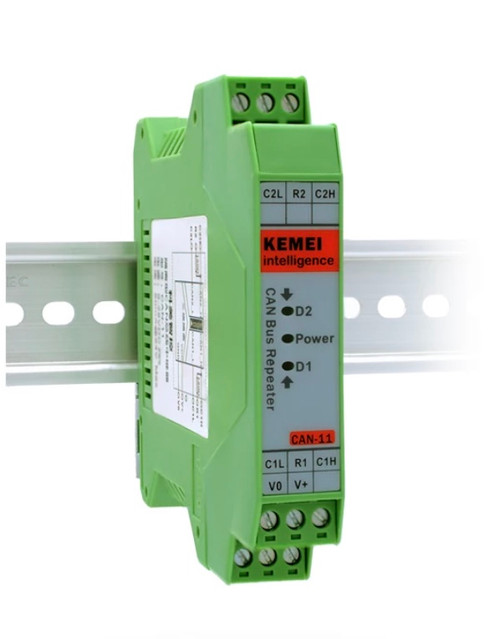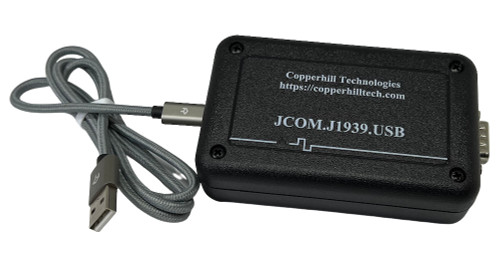Blog
Recent Posts
Introducing the CAN‑11: DIN‑Rail Isolated CAN Bus Repeater
Posted by on
 In modern SAE J1939 and CAN bus systems, extending bus length, increasing node count, or improving network topology can expose signals to noise, ground loops, and timing issues. Copperhill’s CAN‑11 CAN Bus DIN‑Rail Isolated Repeater makes these challenges easy to overcome while preserving seamless CAN communication.
In modern SAE J1939 and CAN bus systems, extending bus length, increasing node count, or improving network topology can expose signals to noise, ground loops, and timing issues. Copperhill’s CAN‑11 CAN Bus DIN‑Rail Isolated Repeater makes these challenges easy to overcome while preserving seamless CAN communication.
Key Features of the CAN‑11
-
1.5 kV magnetic‑coupling isolation, shielding CAN segments from surges and eliminating ground‑loop interference.
-
Support for CAN 2.0A/B.
-
Wide baud‑rate range (10 kbps to 1 Mbps), with adaptive auto‑configuration to match your network.
-
Ultra‑low loopback delay (~110 ns) and support for up to 110 nodes, keeping real‑time performance intact.
-
Built‑in bus arbitration logic and Dominant Timeout (DTO) to isolate faulty segments automatically.
-
Compact DIN‑rail mount design with detachable screw terminals, LED status indicators, and wide input voltage (9–28 VDC) and temperature range (–25 °C to +70 °C).
Why Use a CAN Bus Repeater?
From Copperhill’s industry insight and jcom1939’s technical overview, CAN repeaters like CAN‑11 are essential when advanced CAN bus installations demand reliability, scalability, and clarity:
-
Extend and reconfigure physical networks – Repeaters let you expand bus length or adapt star/tree layouts while keeping a unified network view. Ideal when all nodes need to see all messages transparently.
-
Preserve signal integrity across long or noisy lines – Isolation blocks surges and ground loops, preventing transceiver damage and communication errors.
-
Scale node count – With support for over 100 nodes and proper termination across segments, CAN‑11 helps you grow without violating CAN bus electrical limits.
-
Maintain timing and protocol transparency – Thanks to sub‑microsecond propagation delay and adaptive baud‑rate logic, the bus behaves as if it were a single uninterrupted segment, ensuring compatibility with SAE J1939, CANopen, and other higher layer standards.
-
Automatic failure isolation – The DTO mechanism isolates one end of the bus if dominant errors persist, allowing unaffected nodes to continue normal communication uninterrupted.
Ideal Applications
-
Heavy-duty vehicle networks (SAE J1939): Perfect for rugged, long‑distance wiring in trucks, buses, or agricultural machinery.
-
Industrial automation: Star or tree‑topology CAN networks across factory floors, PLCs, sensors, and control modules.
-
Instrumentation & IoT: Reliable expansions in distributed sensing environments with EMI concerns.
Benefits at a Glance
| Benefit | Value Proposition |
|---|---|
| Electrical isolation | Protects equipment; reduces noise and ground-loop faults. |
| Flexible topology support | Enables linear, star, and tree configurations. |
| Minimal impact on bus timing | Keeps real-time control applications stable. |
| Scalable node support | Supports large networks beyond conventional CAN limits. |
| Plug-and-play installation | DIN‑rail mount with LEDs and detachable terminals simplifies deployment. |
Why Choose Copperhill Technologies?
With deep expertise in SAE J1939, Copperhill offers not just premium hardware, but integration into a full ecosystem—including the JCOM1939 Monitor and Simulator, extensive J1939 documentation, and developer support. Whether troubleshooting live bus traffic or simulating complex PGN scenarios, their tools complement the CAN‑11 for seamless J1939 workflows.
Final Thoughts
If your application requires longer or more complex CAN networks without sacrificing reliability, the CAN‑11 Repeater delivers industrial-grade isolation, plug‑and‑play simplicity, and advanced fault isolation—all while maintaining the deterministic integrity that defines CAN bus systems. It’s the smart choice for engineers who demand robustness and scalability in harsh or large systems.
References
-
Copperhill Technologies, CAN‑11 CAN Bus DIN Rail Isolated Repeater product info.
-
Copperhill blog, CAN Bus Repeaters: Overview and Technical Considerations (June 6, 2025)
-
Copperhill blog, Understanding SAE J1939: A Comprehensive Guide… for their software ecosystem and J1939 expertise.
 SAE J1939 to USB Gateway for Network Analysis
SAE J1939 to USB Gateway for Network Analysis
The SAE J1939 gateway provides a comprehensive solution for monitoring, simulating, and recording any Parameter Group Number (PGN) as specified in the SAE J1939-71 standard. Additionally, it supports the analysis of diagnostic messages in accordance with the SAE J1939-73 standard, making it a versatile tool for troubleshooting and performance optimization.
To enhance usability, the gateway is fully compatible with our free JCOM1939 Monitor software, a powerful Windows-based application designed for SAE J1939 monitoring, in-depth analysis, and ECU simulation. This software allows users to visualize real-time data, decode network traffic, and perform advanced diagnostics, making it an essential tool for engineers, developers, and technicians working with SAE J1939 systems. More Information...
 Loading... Please wait...
Loading... Please wait...
